Business Law Report: English Legal System and Employer Obligations
VerifiedAdded on 2020/07/22
|14
|4091
|71
Report
AI Summary
This business law report offers a comprehensive analysis of the English legal system, including its structure, sources of law, and the role of government in law-making. It explores the effectiveness of the legal system, recent reforms, and developments. The report delves into employer obligations, differentiating between legislations, regulations, and standards, and analyzing their impact on businesses. It suggests appropriate legal solutions for various business problems, justifies these solutions, and assesses their impact. Furthermore, it explains alternative dispute resolution mechanisms and recommends their use. The report covers topics such as statutory and common law, health and safety, workplace compensation, harassment, and equal opportunities, providing a detailed understanding of business law principles and their practical applications. The report is contributed by a student and is available on Desklib, a platform offering AI-based study tools for students.
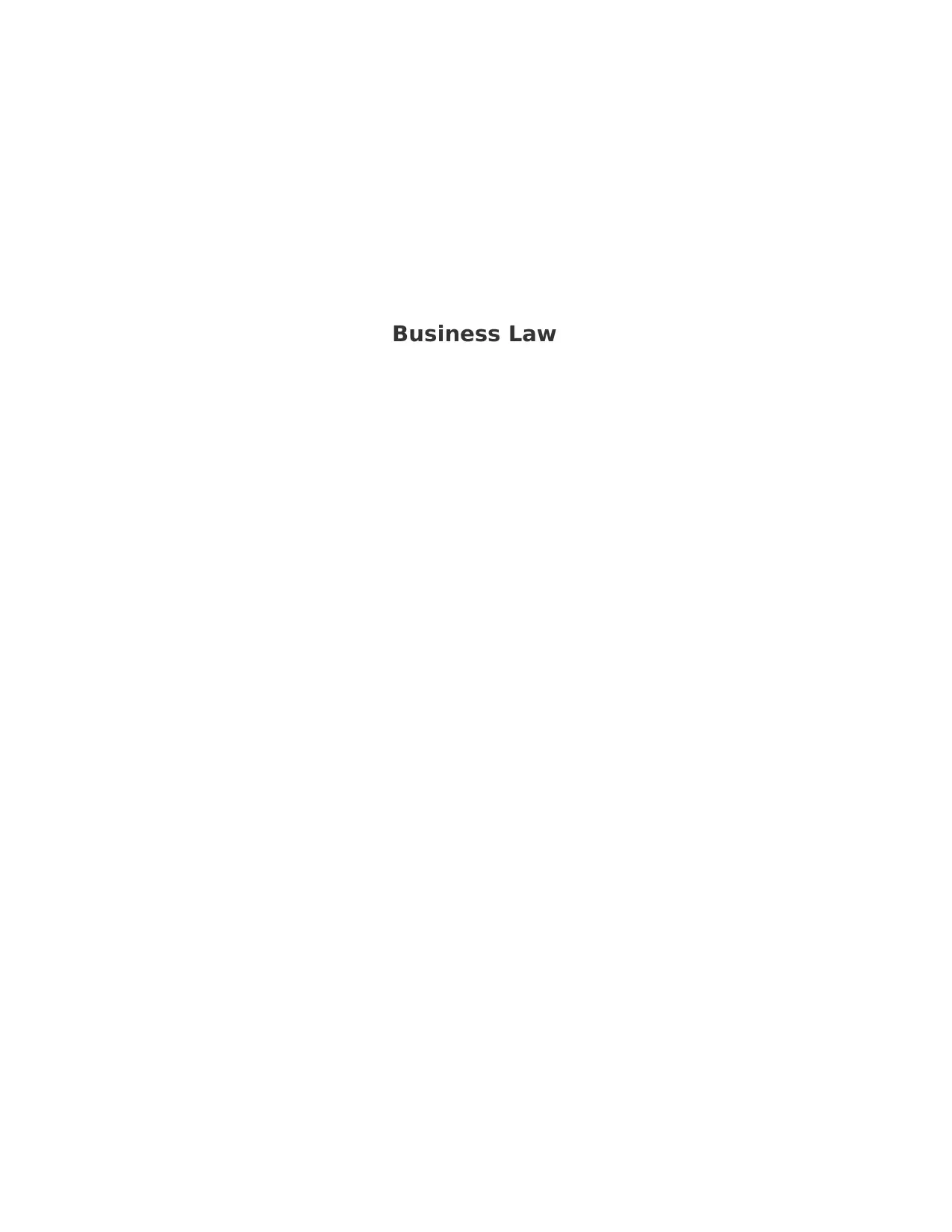
Business Law
Paraphrase This Document
Need a fresh take? Get an instant paraphrase of this document with our AI Paraphraser
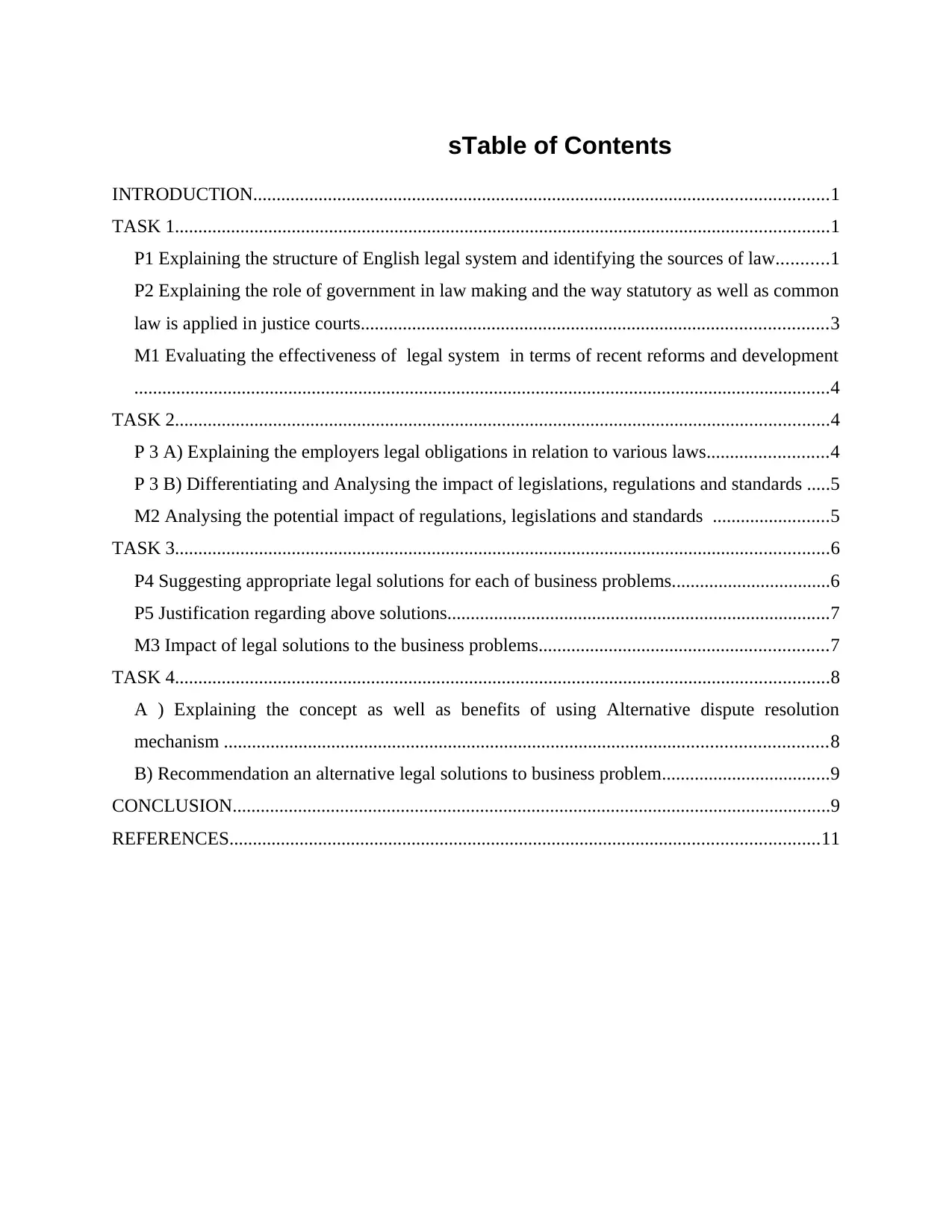
sTable of Contents
INTRODUCTION...........................................................................................................................1
TASK 1............................................................................................................................................1
P1 Explaining the structure of English legal system and identifying the sources of law...........1
P2 Explaining the role of government in law making and the way statutory as well as common
law is applied in justice courts....................................................................................................3
M1 Evaluating the effectiveness of legal system in terms of recent reforms and development
.....................................................................................................................................................4
TASK 2............................................................................................................................................4
P 3 A) Explaining the employers legal obligations in relation to various laws..........................4
P 3 B) Differentiating and Analysing the impact of legislations, regulations and standards .....5
M2 Analysing the potential impact of regulations, legislations and standards .........................5
TASK 3............................................................................................................................................6
P4 Suggesting appropriate legal solutions for each of business problems..................................6
P5 Justification regarding above solutions..................................................................................7
M3 Impact of legal solutions to the business problems..............................................................7
TASK 4............................................................................................................................................8
A ) Explaining the concept as well as benefits of using Alternative dispute resolution
mechanism .................................................................................................................................8
B) Recommendation an alternative legal solutions to business problem....................................9
CONCLUSION................................................................................................................................9
REFERENCES..............................................................................................................................11
INTRODUCTION...........................................................................................................................1
TASK 1............................................................................................................................................1
P1 Explaining the structure of English legal system and identifying the sources of law...........1
P2 Explaining the role of government in law making and the way statutory as well as common
law is applied in justice courts....................................................................................................3
M1 Evaluating the effectiveness of legal system in terms of recent reforms and development
.....................................................................................................................................................4
TASK 2............................................................................................................................................4
P 3 A) Explaining the employers legal obligations in relation to various laws..........................4
P 3 B) Differentiating and Analysing the impact of legislations, regulations and standards .....5
M2 Analysing the potential impact of regulations, legislations and standards .........................5
TASK 3............................................................................................................................................6
P4 Suggesting appropriate legal solutions for each of business problems..................................6
P5 Justification regarding above solutions..................................................................................7
M3 Impact of legal solutions to the business problems..............................................................7
TASK 4............................................................................................................................................8
A ) Explaining the concept as well as benefits of using Alternative dispute resolution
mechanism .................................................................................................................................8
B) Recommendation an alternative legal solutions to business problem....................................9
CONCLUSION................................................................................................................................9
REFERENCES..............................................................................................................................11

⊘ This is a preview!⊘
Do you want full access?
Subscribe today to unlock all pages.

Trusted by 1+ million students worldwide
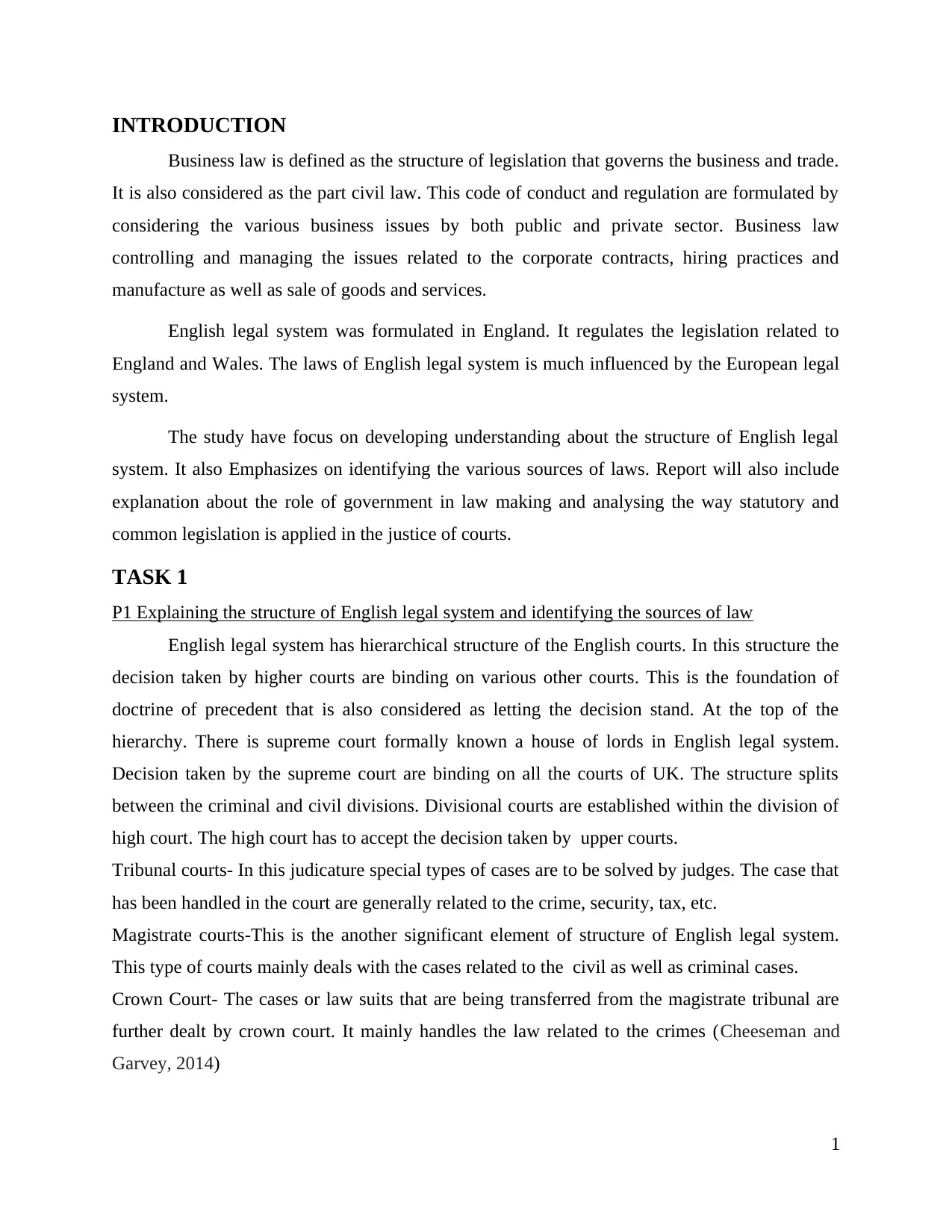
INTRODUCTION
Business law is defined as the structure of legislation that governs the business and trade.
It is also considered as the part civil law. This code of conduct and regulation are formulated by
considering the various business issues by both public and private sector. Business law
controlling and managing the issues related to the corporate contracts, hiring practices and
manufacture as well as sale of goods and services.
English legal system was formulated in England. It regulates the legislation related to
England and Wales. The laws of English legal system is much influenced by the European legal
system.
The study have focus on developing understanding about the structure of English legal
system. It also Emphasizes on identifying the various sources of laws. Report will also include
explanation about the role of government in law making and analysing the way statutory and
common legislation is applied in the justice of courts.
TASK 1
P1 Explaining the structure of English legal system and identifying the sources of law
English legal system has hierarchical structure of the English courts. In this structure the
decision taken by higher courts are binding on various other courts. This is the foundation of
doctrine of precedent that is also considered as letting the decision stand. At the top of the
hierarchy. There is supreme court formally known a house of lords in English legal system.
Decision taken by the supreme court are binding on all the courts of UK. The structure splits
between the criminal and civil divisions. Divisional courts are established within the division of
high court. The high court has to accept the decision taken by upper courts.
Tribunal courts- In this judicature special types of cases are to be solved by judges. The case that
has been handled in the court are generally related to the crime, security, tax, etc.
Magistrate courts-This is the another significant element of structure of English legal system.
This type of courts mainly deals with the cases related to the civil as well as criminal cases.
Crown Court- The cases or law suits that are being transferred from the magistrate tribunal are
further dealt by crown court. It mainly handles the law related to the crimes (Cheeseman and
Garvey, 2014)
1
Business law is defined as the structure of legislation that governs the business and trade.
It is also considered as the part civil law. This code of conduct and regulation are formulated by
considering the various business issues by both public and private sector. Business law
controlling and managing the issues related to the corporate contracts, hiring practices and
manufacture as well as sale of goods and services.
English legal system was formulated in England. It regulates the legislation related to
England and Wales. The laws of English legal system is much influenced by the European legal
system.
The study have focus on developing understanding about the structure of English legal
system. It also Emphasizes on identifying the various sources of laws. Report will also include
explanation about the role of government in law making and analysing the way statutory and
common legislation is applied in the justice of courts.
TASK 1
P1 Explaining the structure of English legal system and identifying the sources of law
English legal system has hierarchical structure of the English courts. In this structure the
decision taken by higher courts are binding on various other courts. This is the foundation of
doctrine of precedent that is also considered as letting the decision stand. At the top of the
hierarchy. There is supreme court formally known a house of lords in English legal system.
Decision taken by the supreme court are binding on all the courts of UK. The structure splits
between the criminal and civil divisions. Divisional courts are established within the division of
high court. The high court has to accept the decision taken by upper courts.
Tribunal courts- In this judicature special types of cases are to be solved by judges. The case that
has been handled in the court are generally related to the crime, security, tax, etc.
Magistrate courts-This is the another significant element of structure of English legal system.
This type of courts mainly deals with the cases related to the civil as well as criminal cases.
Crown Court- The cases or law suits that are being transferred from the magistrate tribunal are
further dealt by crown court. It mainly handles the law related to the crimes (Cheeseman and
Garvey, 2014)
1
Paraphrase This Document
Need a fresh take? Get an instant paraphrase of this document with our AI Paraphraser
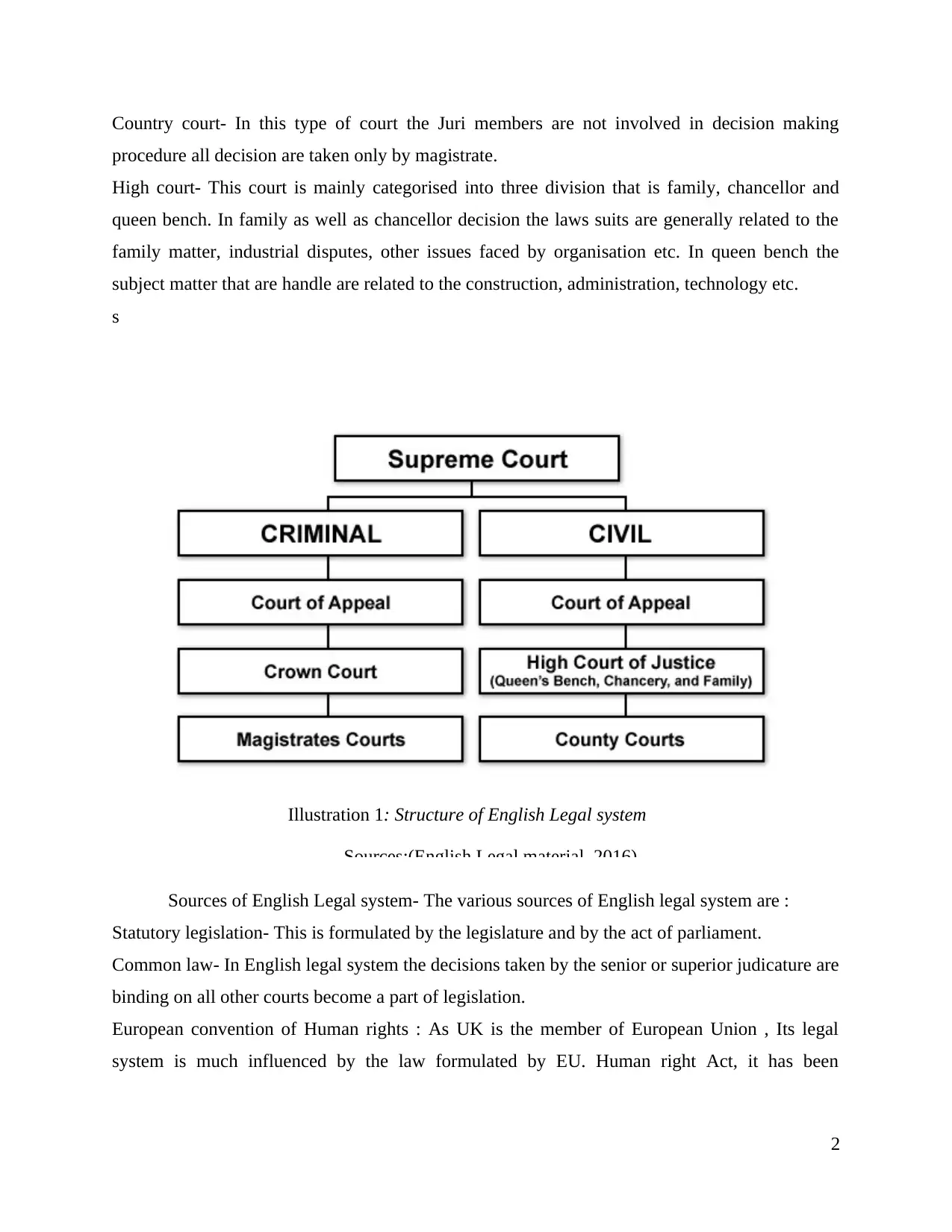
Country court- In this type of court the Juri members are not involved in decision making
procedure all decision are taken only by magistrate.
High court- This court is mainly categorised into three division that is family, chancellor and
queen bench. In family as well as chancellor decision the laws suits are generally related to the
family matter, industrial disputes, other issues faced by organisation etc. In queen bench the
subject matter that are handle are related to the construction, administration, technology etc.
s
Sources of English Legal system- The various sources of English legal system are :
Statutory legislation- This is formulated by the legislature and by the act of parliament.
Common law- In English legal system the decisions taken by the senior or superior judicature are
binding on all other courts become a part of legislation.
European convention of Human rights : As UK is the member of European Union , Its legal
system is much influenced by the law formulated by EU. Human right Act, it has been
2
Illustration 1: Structure of English Legal system
Sources:(English Legal material, 2016)
procedure all decision are taken only by magistrate.
High court- This court is mainly categorised into three division that is family, chancellor and
queen bench. In family as well as chancellor decision the laws suits are generally related to the
family matter, industrial disputes, other issues faced by organisation etc. In queen bench the
subject matter that are handle are related to the construction, administration, technology etc.
s
Sources of English Legal system- The various sources of English legal system are :
Statutory legislation- This is formulated by the legislature and by the act of parliament.
Common law- In English legal system the decisions taken by the senior or superior judicature are
binding on all other courts become a part of legislation.
European convention of Human rights : As UK is the member of European Union , Its legal
system is much influenced by the law formulated by EU. Human right Act, it has been
2
Illustration 1: Structure of English Legal system
Sources:(English Legal material, 2016)
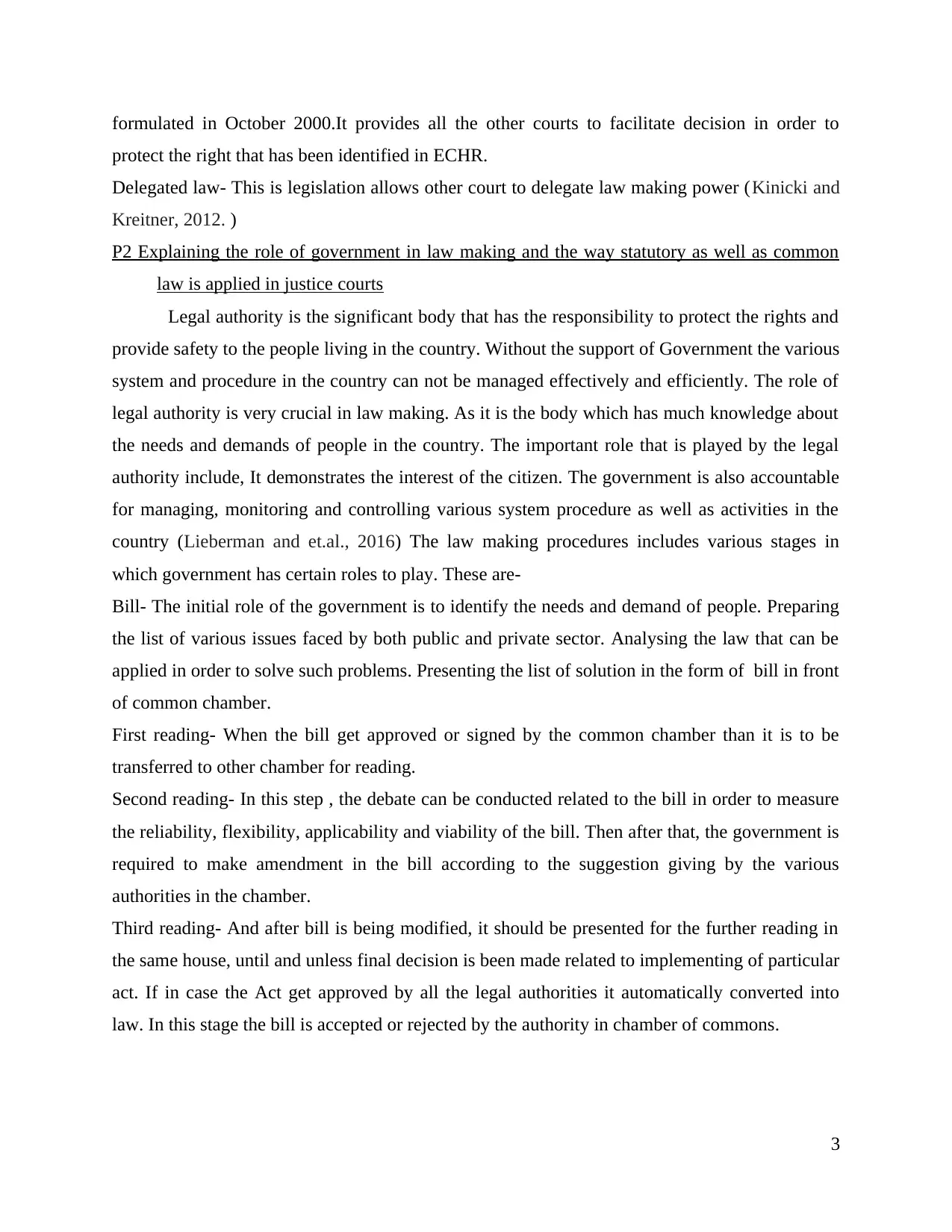
formulated in October 2000.It provides all the other courts to facilitate decision in order to
protect the right that has been identified in ECHR.
Delegated law- This is legislation allows other court to delegate law making power (Kinicki and
Kreitner, 2012. )
P2 Explaining the role of government in law making and the way statutory as well as common
law is applied in justice courts
Legal authority is the significant body that has the responsibility to protect the rights and
provide safety to the people living in the country. Without the support of Government the various
system and procedure in the country can not be managed effectively and efficiently. The role of
legal authority is very crucial in law making. As it is the body which has much knowledge about
the needs and demands of people in the country. The important role that is played by the legal
authority include, It demonstrates the interest of the citizen. The government is also accountable
for managing, monitoring and controlling various system procedure as well as activities in the
country (Lieberman and et.al., 2016) The law making procedures includes various stages in
which government has certain roles to play. These are-
Bill- The initial role of the government is to identify the needs and demand of people. Preparing
the list of various issues faced by both public and private sector. Analysing the law that can be
applied in order to solve such problems. Presenting the list of solution in the form of bill in front
of common chamber.
First reading- When the bill get approved or signed by the common chamber than it is to be
transferred to other chamber for reading.
Second reading- In this step , the debate can be conducted related to the bill in order to measure
the reliability, flexibility, applicability and viability of the bill. Then after that, the government is
required to make amendment in the bill according to the suggestion giving by the various
authorities in the chamber.
Third reading- And after bill is being modified, it should be presented for the further reading in
the same house, until and unless final decision is been made related to implementing of particular
act. If in case the Act get approved by all the legal authorities it automatically converted into
law. In this stage the bill is accepted or rejected by the authority in chamber of commons.
3
protect the right that has been identified in ECHR.
Delegated law- This is legislation allows other court to delegate law making power (Kinicki and
Kreitner, 2012. )
P2 Explaining the role of government in law making and the way statutory as well as common
law is applied in justice courts
Legal authority is the significant body that has the responsibility to protect the rights and
provide safety to the people living in the country. Without the support of Government the various
system and procedure in the country can not be managed effectively and efficiently. The role of
legal authority is very crucial in law making. As it is the body which has much knowledge about
the needs and demands of people in the country. The important role that is played by the legal
authority include, It demonstrates the interest of the citizen. The government is also accountable
for managing, monitoring and controlling various system procedure as well as activities in the
country (Lieberman and et.al., 2016) The law making procedures includes various stages in
which government has certain roles to play. These are-
Bill- The initial role of the government is to identify the needs and demand of people. Preparing
the list of various issues faced by both public and private sector. Analysing the law that can be
applied in order to solve such problems. Presenting the list of solution in the form of bill in front
of common chamber.
First reading- When the bill get approved or signed by the common chamber than it is to be
transferred to other chamber for reading.
Second reading- In this step , the debate can be conducted related to the bill in order to measure
the reliability, flexibility, applicability and viability of the bill. Then after that, the government is
required to make amendment in the bill according to the suggestion giving by the various
authorities in the chamber.
Third reading- And after bill is being modified, it should be presented for the further reading in
the same house, until and unless final decision is been made related to implementing of particular
act. If in case the Act get approved by all the legal authorities it automatically converted into
law. In this stage the bill is accepted or rejected by the authority in chamber of commons.
3
⊘ This is a preview!⊘
Do you want full access?
Subscribe today to unlock all pages.

Trusted by 1+ million students worldwide
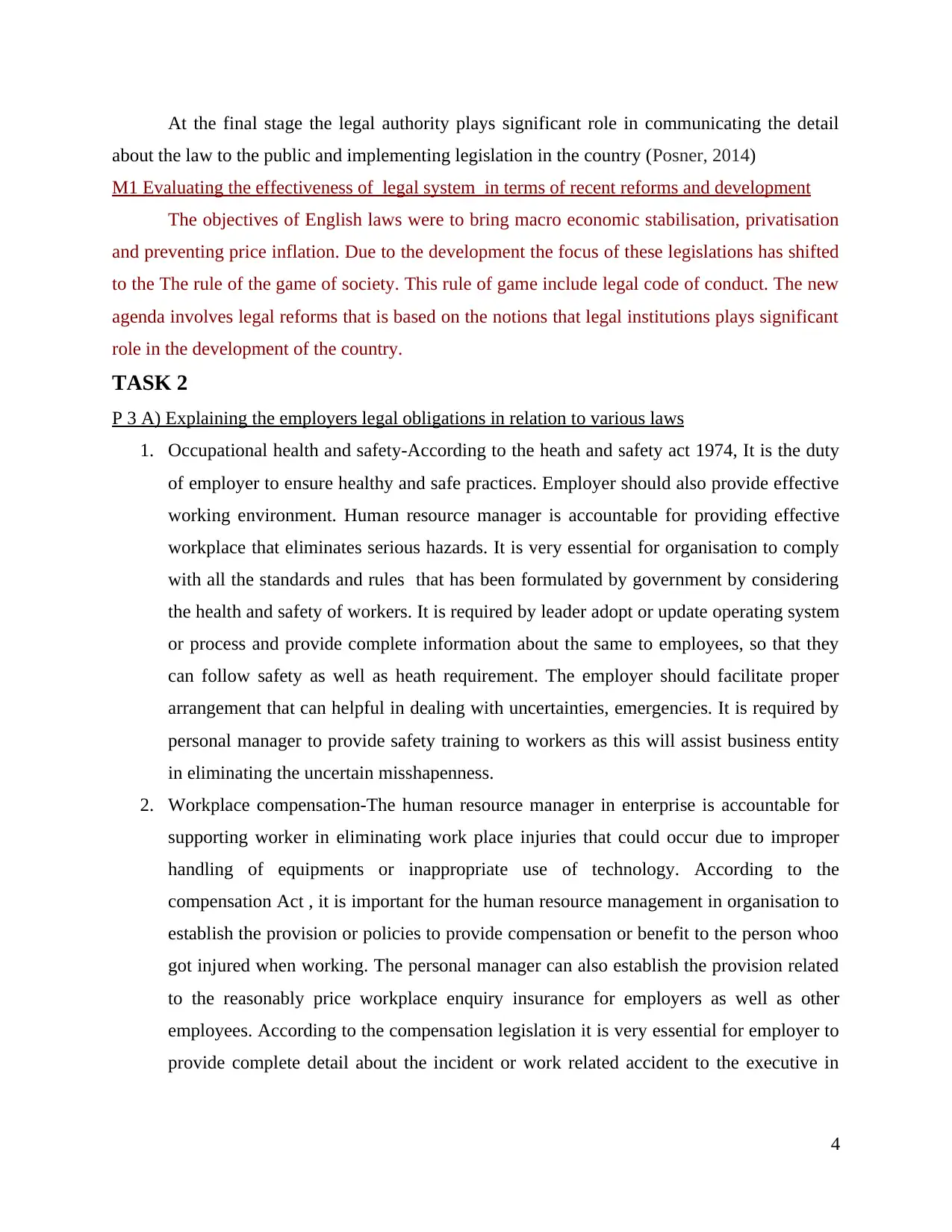
At the final stage the legal authority plays significant role in communicating the detail
about the law to the public and implementing legislation in the country (Posner, 2014)
M1 Evaluating the effectiveness of legal system in terms of recent reforms and development
The objectives of English laws were to bring macro economic stabilisation, privatisation
and preventing price inflation. Due to the development the focus of these legislations has shifted
to the The rule of the game of society. This rule of game include legal code of conduct. The new
agenda involves legal reforms that is based on the notions that legal institutions plays significant
role in the development of the country.
TASK 2
P 3 A) Explaining the employers legal obligations in relation to various laws
1. Occupational health and safety-According to the heath and safety act 1974, It is the duty
of employer to ensure healthy and safe practices. Employer should also provide effective
working environment. Human resource manager is accountable for providing effective
workplace that eliminates serious hazards. It is very essential for organisation to comply
with all the standards and rules that has been formulated by government by considering
the health and safety of workers. It is required by leader adopt or update operating system
or process and provide complete information about the same to employees, so that they
can follow safety as well as heath requirement. The employer should facilitate proper
arrangement that can helpful in dealing with uncertainties, emergencies. It is required by
personal manager to provide safety training to workers as this will assist business entity
in eliminating the uncertain misshapenness.
2. Workplace compensation-The human resource manager in enterprise is accountable for
supporting worker in eliminating work place injuries that could occur due to improper
handling of equipments or inappropriate use of technology. According to the
compensation Act , it is important for the human resource management in organisation to
establish the provision or policies to provide compensation or benefit to the person whoo
got injured when working. The personal manager can also establish the provision related
to the reasonably price workplace enquiry insurance for employers as well as other
employees. According to the compensation legislation it is very essential for employer to
provide complete detail about the incident or work related accident to the executive in
4
about the law to the public and implementing legislation in the country (Posner, 2014)
M1 Evaluating the effectiveness of legal system in terms of recent reforms and development
The objectives of English laws were to bring macro economic stabilisation, privatisation
and preventing price inflation. Due to the development the focus of these legislations has shifted
to the The rule of the game of society. This rule of game include legal code of conduct. The new
agenda involves legal reforms that is based on the notions that legal institutions plays significant
role in the development of the country.
TASK 2
P 3 A) Explaining the employers legal obligations in relation to various laws
1. Occupational health and safety-According to the heath and safety act 1974, It is the duty
of employer to ensure healthy and safe practices. Employer should also provide effective
working environment. Human resource manager is accountable for providing effective
workplace that eliminates serious hazards. It is very essential for organisation to comply
with all the standards and rules that has been formulated by government by considering
the health and safety of workers. It is required by leader adopt or update operating system
or process and provide complete information about the same to employees, so that they
can follow safety as well as heath requirement. The employer should facilitate proper
arrangement that can helpful in dealing with uncertainties, emergencies. It is required by
personal manager to provide safety training to workers as this will assist business entity
in eliminating the uncertain misshapenness.
2. Workplace compensation-The human resource manager in enterprise is accountable for
supporting worker in eliminating work place injuries that could occur due to improper
handling of equipments or inappropriate use of technology. According to the
compensation Act , it is important for the human resource management in organisation to
establish the provision or policies to provide compensation or benefit to the person whoo
got injured when working. The personal manager can also establish the provision related
to the reasonably price workplace enquiry insurance for employers as well as other
employees. According to the compensation legislation it is very essential for employer to
provide complete detail about the incident or work related accident to the executive in
4
Paraphrase This Document
Need a fresh take? Get an instant paraphrase of this document with our AI Paraphraser
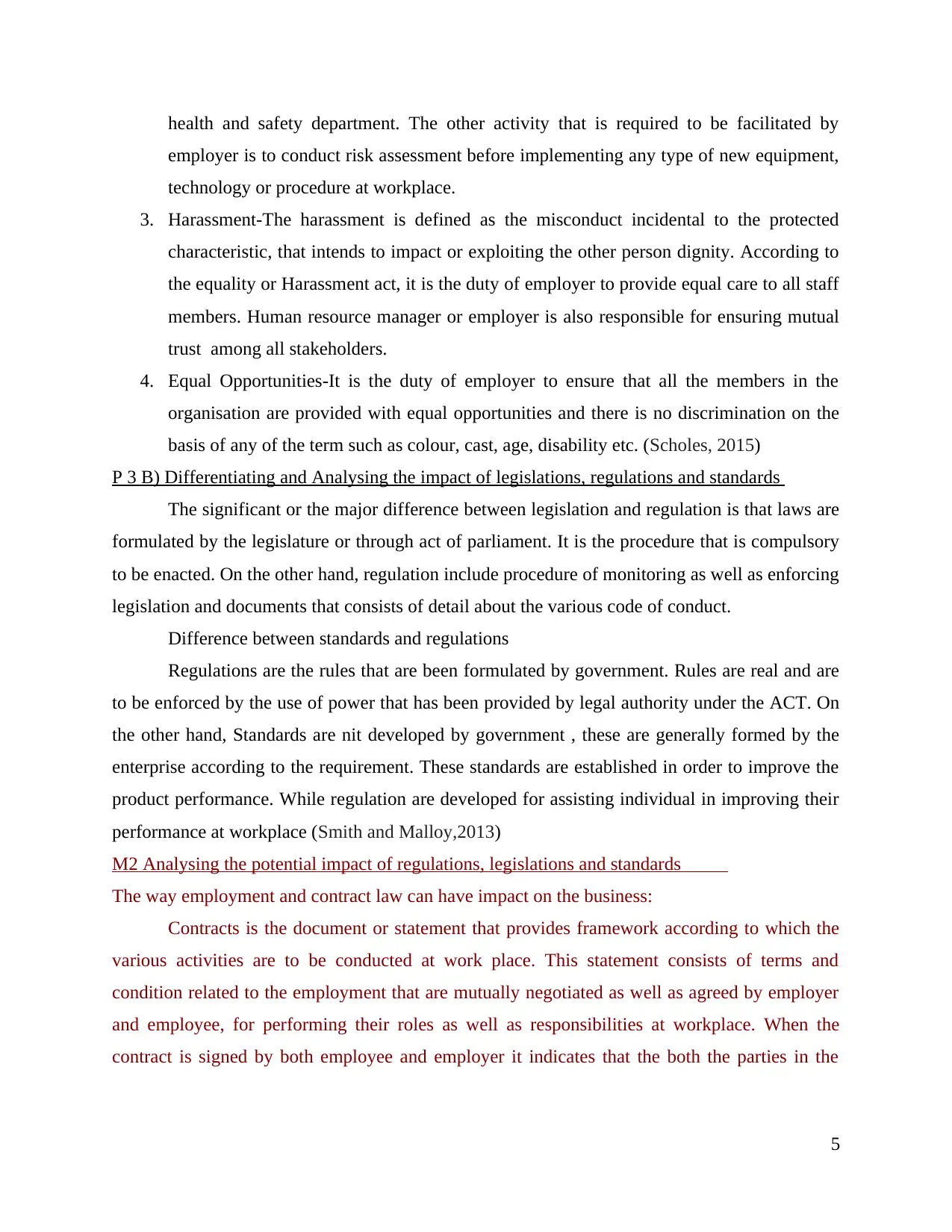
health and safety department. The other activity that is required to be facilitated by
employer is to conduct risk assessment before implementing any type of new equipment,
technology or procedure at workplace.
3. Harassment-The harassment is defined as the misconduct incidental to the protected
characteristic, that intends to impact or exploiting the other person dignity. According to
the equality or Harassment act, it is the duty of employer to provide equal care to all staff
members. Human resource manager or employer is also responsible for ensuring mutual
trust among all stakeholders.
4. Equal Opportunities-It is the duty of employer to ensure that all the members in the
organisation are provided with equal opportunities and there is no discrimination on the
basis of any of the term such as colour, cast, age, disability etc. (Scholes, 2015)
P 3 B) Differentiating and Analysing the impact of legislations, regulations and standards
The significant or the major difference between legislation and regulation is that laws are
formulated by the legislature or through act of parliament. It is the procedure that is compulsory
to be enacted. On the other hand, regulation include procedure of monitoring as well as enforcing
legislation and documents that consists of detail about the various code of conduct.
Difference between standards and regulations
Regulations are the rules that are been formulated by government. Rules are real and are
to be enforced by the use of power that has been provided by legal authority under the ACT. On
the other hand, Standards are nit developed by government , these are generally formed by the
enterprise according to the requirement. These standards are established in order to improve the
product performance. While regulation are developed for assisting individual in improving their
performance at workplace (Smith and Malloy,2013)
M2 Analysing the potential impact of regulations, legislations and standards
The way employment and contract law can have impact on the business:
Contracts is the document or statement that provides framework according to which the
various activities are to be conducted at work place. This statement consists of terms and
condition related to the employment that are mutually negotiated as well as agreed by employer
and employee, for performing their roles as well as responsibilities at workplace. When the
contract is signed by both employee and employer it indicates that the both the parties in the
5
employer is to conduct risk assessment before implementing any type of new equipment,
technology or procedure at workplace.
3. Harassment-The harassment is defined as the misconduct incidental to the protected
characteristic, that intends to impact or exploiting the other person dignity. According to
the equality or Harassment act, it is the duty of employer to provide equal care to all staff
members. Human resource manager or employer is also responsible for ensuring mutual
trust among all stakeholders.
4. Equal Opportunities-It is the duty of employer to ensure that all the members in the
organisation are provided with equal opportunities and there is no discrimination on the
basis of any of the term such as colour, cast, age, disability etc. (Scholes, 2015)
P 3 B) Differentiating and Analysing the impact of legislations, regulations and standards
The significant or the major difference between legislation and regulation is that laws are
formulated by the legislature or through act of parliament. It is the procedure that is compulsory
to be enacted. On the other hand, regulation include procedure of monitoring as well as enforcing
legislation and documents that consists of detail about the various code of conduct.
Difference between standards and regulations
Regulations are the rules that are been formulated by government. Rules are real and are
to be enforced by the use of power that has been provided by legal authority under the ACT. On
the other hand, Standards are nit developed by government , these are generally formed by the
enterprise according to the requirement. These standards are established in order to improve the
product performance. While regulation are developed for assisting individual in improving their
performance at workplace (Smith and Malloy,2013)
M2 Analysing the potential impact of regulations, legislations and standards
The way employment and contract law can have impact on the business:
Contracts is the document or statement that provides framework according to which the
various activities are to be conducted at work place. This statement consists of terms and
condition related to the employment that are mutually negotiated as well as agreed by employer
and employee, for performing their roles as well as responsibilities at workplace. When the
contract is signed by both employee and employer it indicates that the both the parties in the
5
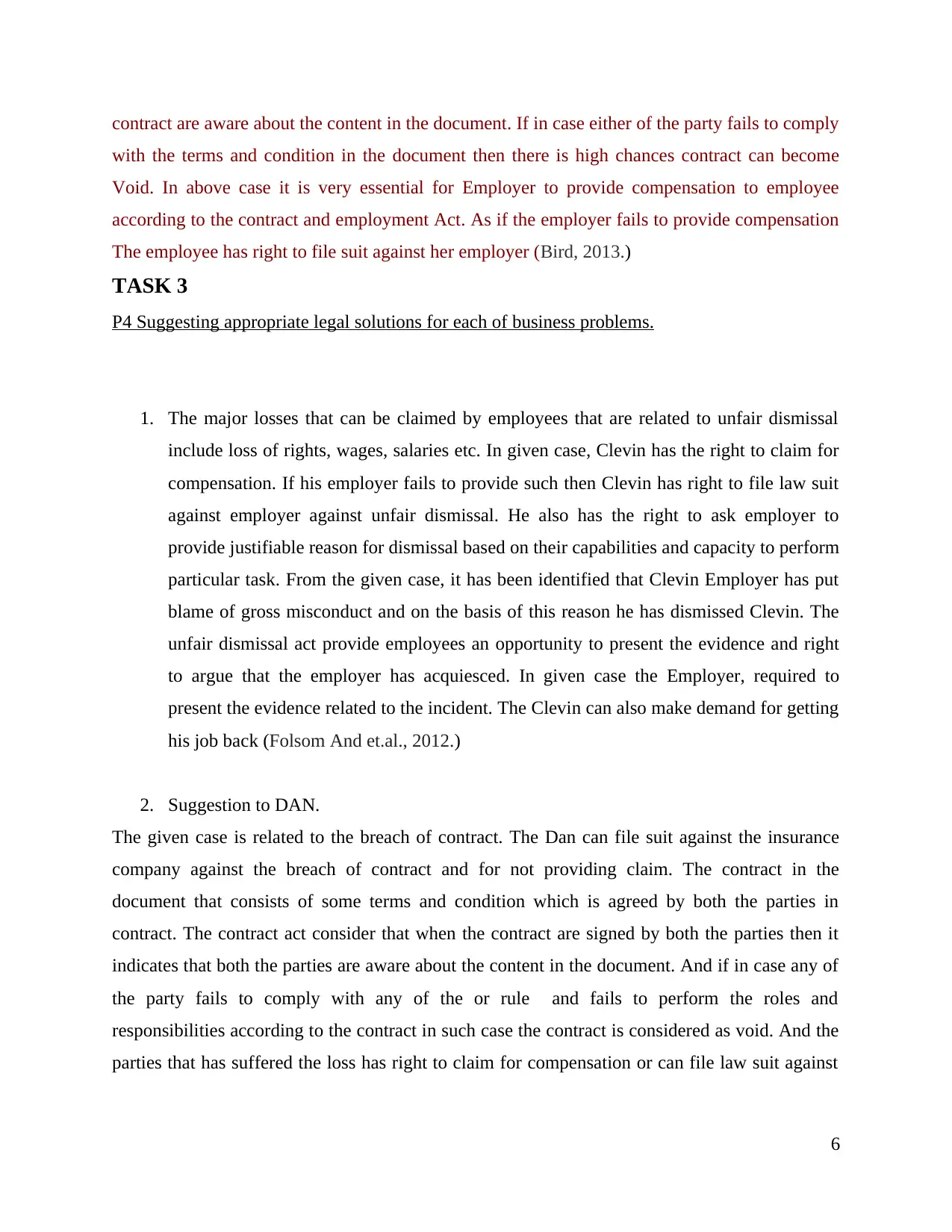
contract are aware about the content in the document. If in case either of the party fails to comply
with the terms and condition in the document then there is high chances contract can become
Void. In above case it is very essential for Employer to provide compensation to employee
according to the contract and employment Act. As if the employer fails to provide compensation
The employee has right to file suit against her employer (Bird, 2013.)
TASK 3
P4 Suggesting appropriate legal solutions for each of business problems.
1. The major losses that can be claimed by employees that are related to unfair dismissal
include loss of rights, wages, salaries etc. In given case, Clevin has the right to claim for
compensation. If his employer fails to provide such then Clevin has right to file law suit
against employer against unfair dismissal. He also has the right to ask employer to
provide justifiable reason for dismissal based on their capabilities and capacity to perform
particular task. From the given case, it has been identified that Clevin Employer has put
blame of gross misconduct and on the basis of this reason he has dismissed Clevin. The
unfair dismissal act provide employees an opportunity to present the evidence and right
to argue that the employer has acquiesced. In given case the Employer, required to
present the evidence related to the incident. The Clevin can also make demand for getting
his job back (Folsom And et.al., 2012.)
2. Suggestion to DAN.
The given case is related to the breach of contract. The Dan can file suit against the insurance
company against the breach of contract and for not providing claim. The contract in the
document that consists of some terms and condition which is agreed by both the parties in
contract. The contract act consider that when the contract are signed by both the parties then it
indicates that both the parties are aware about the content in the document. And if in case any of
the party fails to comply with any of the or rule and fails to perform the roles and
responsibilities according to the contract in such case the contract is considered as void. And the
parties that has suffered the loss has right to claim for compensation or can file law suit against
6
with the terms and condition in the document then there is high chances contract can become
Void. In above case it is very essential for Employer to provide compensation to employee
according to the contract and employment Act. As if the employer fails to provide compensation
The employee has right to file suit against her employer (Bird, 2013.)
TASK 3
P4 Suggesting appropriate legal solutions for each of business problems.
1. The major losses that can be claimed by employees that are related to unfair dismissal
include loss of rights, wages, salaries etc. In given case, Clevin has the right to claim for
compensation. If his employer fails to provide such then Clevin has right to file law suit
against employer against unfair dismissal. He also has the right to ask employer to
provide justifiable reason for dismissal based on their capabilities and capacity to perform
particular task. From the given case, it has been identified that Clevin Employer has put
blame of gross misconduct and on the basis of this reason he has dismissed Clevin. The
unfair dismissal act provide employees an opportunity to present the evidence and right
to argue that the employer has acquiesced. In given case the Employer, required to
present the evidence related to the incident. The Clevin can also make demand for getting
his job back (Folsom And et.al., 2012.)
2. Suggestion to DAN.
The given case is related to the breach of contract. The Dan can file suit against the insurance
company against the breach of contract and for not providing claim. The contract in the
document that consists of some terms and condition which is agreed by both the parties in
contract. The contract act consider that when the contract are signed by both the parties then it
indicates that both the parties are aware about the content in the document. And if in case any of
the party fails to comply with any of the or rule and fails to perform the roles and
responsibilities according to the contract in such case the contract is considered as void. And the
parties that has suffered the loss has right to claim for compensation or can file law suit against
6
⊘ This is a preview!⊘
Do you want full access?
Subscribe today to unlock all pages.

Trusted by 1+ million students worldwide
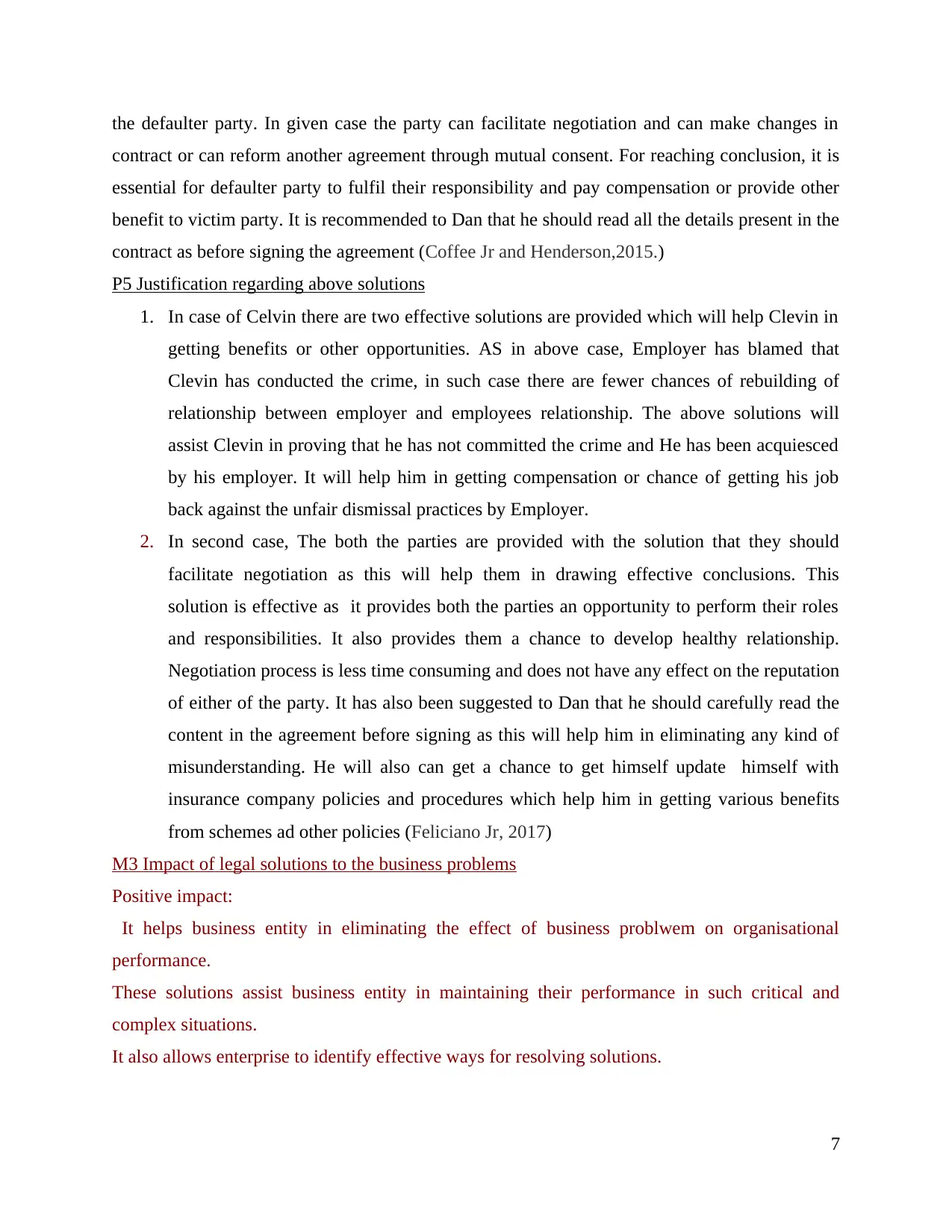
the defaulter party. In given case the party can facilitate negotiation and can make changes in
contract or can reform another agreement through mutual consent. For reaching conclusion, it is
essential for defaulter party to fulfil their responsibility and pay compensation or provide other
benefit to victim party. It is recommended to Dan that he should read all the details present in the
contract as before signing the agreement (Coffee Jr and Henderson,2015.)
P5 Justification regarding above solutions
1. In case of Celvin there are two effective solutions are provided which will help Clevin in
getting benefits or other opportunities. AS in above case, Employer has blamed that
Clevin has conducted the crime, in such case there are fewer chances of rebuilding of
relationship between employer and employees relationship. The above solutions will
assist Clevin in proving that he has not committed the crime and He has been acquiesced
by his employer. It will help him in getting compensation or chance of getting his job
back against the unfair dismissal practices by Employer.
2. In second case, The both the parties are provided with the solution that they should
facilitate negotiation as this will help them in drawing effective conclusions. This
solution is effective as it provides both the parties an opportunity to perform their roles
and responsibilities. It also provides them a chance to develop healthy relationship.
Negotiation process is less time consuming and does not have any effect on the reputation
of either of the party. It has also been suggested to Dan that he should carefully read the
content in the agreement before signing as this will help him in eliminating any kind of
misunderstanding. He will also can get a chance to get himself update himself with
insurance company policies and procedures which help him in getting various benefits
from schemes ad other policies (Feliciano Jr, 2017)
M3 Impact of legal solutions to the business problems
Positive impact:
It helps business entity in eliminating the effect of business problwem on organisational
performance.
These solutions assist business entity in maintaining their performance in such critical and
complex situations.
It also allows enterprise to identify effective ways for resolving solutions.
7
contract or can reform another agreement through mutual consent. For reaching conclusion, it is
essential for defaulter party to fulfil their responsibility and pay compensation or provide other
benefit to victim party. It is recommended to Dan that he should read all the details present in the
contract as before signing the agreement (Coffee Jr and Henderson,2015.)
P5 Justification regarding above solutions
1. In case of Celvin there are two effective solutions are provided which will help Clevin in
getting benefits or other opportunities. AS in above case, Employer has blamed that
Clevin has conducted the crime, in such case there are fewer chances of rebuilding of
relationship between employer and employees relationship. The above solutions will
assist Clevin in proving that he has not committed the crime and He has been acquiesced
by his employer. It will help him in getting compensation or chance of getting his job
back against the unfair dismissal practices by Employer.
2. In second case, The both the parties are provided with the solution that they should
facilitate negotiation as this will help them in drawing effective conclusions. This
solution is effective as it provides both the parties an opportunity to perform their roles
and responsibilities. It also provides them a chance to develop healthy relationship.
Negotiation process is less time consuming and does not have any effect on the reputation
of either of the party. It has also been suggested to Dan that he should carefully read the
content in the agreement before signing as this will help him in eliminating any kind of
misunderstanding. He will also can get a chance to get himself update himself with
insurance company policies and procedures which help him in getting various benefits
from schemes ad other policies (Feliciano Jr, 2017)
M3 Impact of legal solutions to the business problems
Positive impact:
It helps business entity in eliminating the effect of business problwem on organisational
performance.
These solutions assist business entity in maintaining their performance in such critical and
complex situations.
It also allows enterprise to identify effective ways for resolving solutions.
7
Paraphrase This Document
Need a fresh take? Get an instant paraphrase of this document with our AI Paraphraser
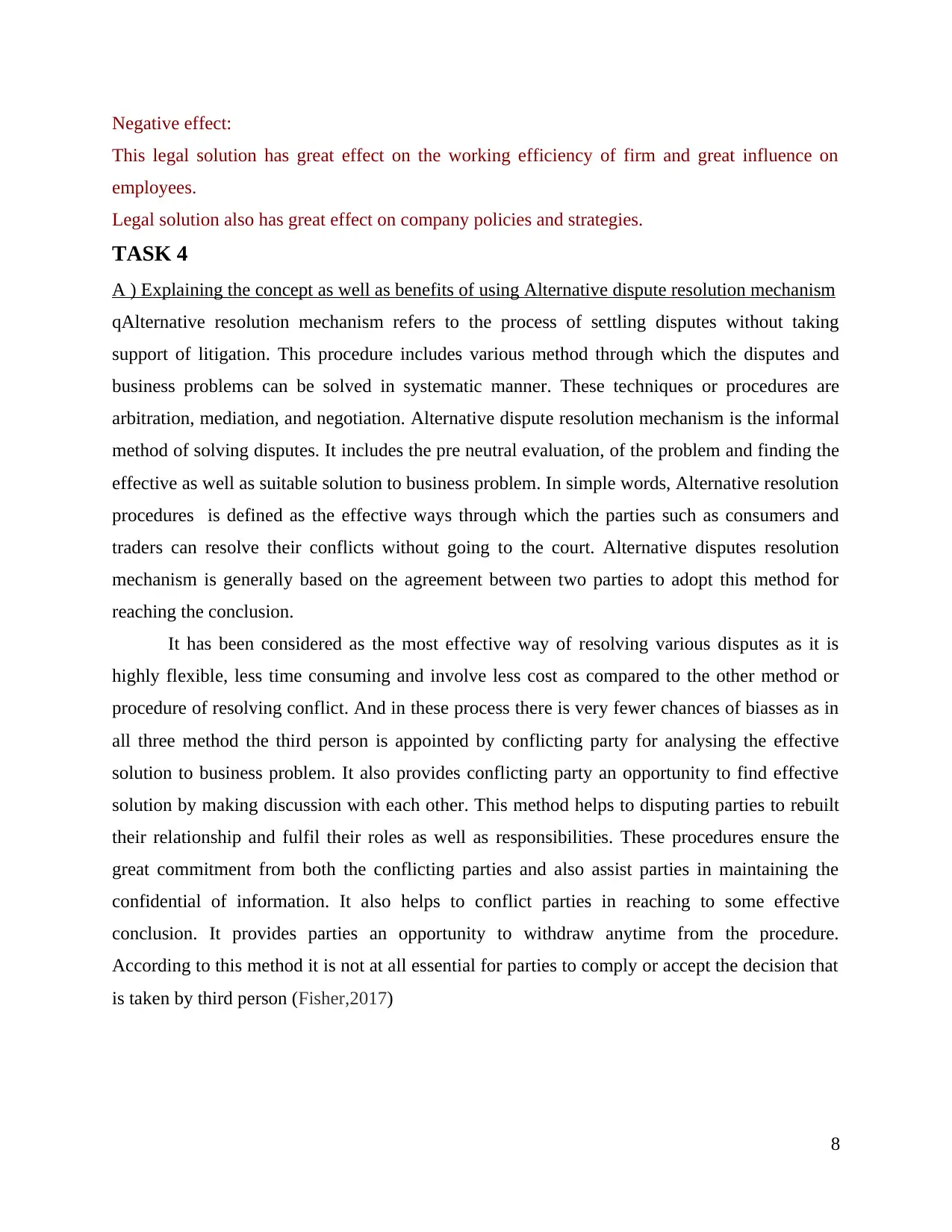
Negative effect:
This legal solution has great effect on the working efficiency of firm and great influence on
employees.
Legal solution also has great effect on company policies and strategies.
TASK 4
A ) Explaining the concept as well as benefits of using Alternative dispute resolution mechanism
qAlternative resolution mechanism refers to the process of settling disputes without taking
support of litigation. This procedure includes various method through which the disputes and
business problems can be solved in systematic manner. These techniques or procedures are
arbitration, mediation, and negotiation. Alternative dispute resolution mechanism is the informal
method of solving disputes. It includes the pre neutral evaluation, of the problem and finding the
effective as well as suitable solution to business problem. In simple words, Alternative resolution
procedures is defined as the effective ways through which the parties such as consumers and
traders can resolve their conflicts without going to the court. Alternative disputes resolution
mechanism is generally based on the agreement between two parties to adopt this method for
reaching the conclusion.
It has been considered as the most effective way of resolving various disputes as it is
highly flexible, less time consuming and involve less cost as compared to the other method or
procedure of resolving conflict. And in these process there is very fewer chances of biasses as in
all three method the third person is appointed by conflicting party for analysing the effective
solution to business problem. It also provides conflicting party an opportunity to find effective
solution by making discussion with each other. This method helps to disputing parties to rebuilt
their relationship and fulfil their roles as well as responsibilities. These procedures ensure the
great commitment from both the conflicting parties and also assist parties in maintaining the
confidential of information. It also helps to conflict parties in reaching to some effective
conclusion. It provides parties an opportunity to withdraw anytime from the procedure.
According to this method it is not at all essential for parties to comply or accept the decision that
is taken by third person (Fisher,2017)
8
This legal solution has great effect on the working efficiency of firm and great influence on
employees.
Legal solution also has great effect on company policies and strategies.
TASK 4
A ) Explaining the concept as well as benefits of using Alternative dispute resolution mechanism
qAlternative resolution mechanism refers to the process of settling disputes without taking
support of litigation. This procedure includes various method through which the disputes and
business problems can be solved in systematic manner. These techniques or procedures are
arbitration, mediation, and negotiation. Alternative dispute resolution mechanism is the informal
method of solving disputes. It includes the pre neutral evaluation, of the problem and finding the
effective as well as suitable solution to business problem. In simple words, Alternative resolution
procedures is defined as the effective ways through which the parties such as consumers and
traders can resolve their conflicts without going to the court. Alternative disputes resolution
mechanism is generally based on the agreement between two parties to adopt this method for
reaching the conclusion.
It has been considered as the most effective way of resolving various disputes as it is
highly flexible, less time consuming and involve less cost as compared to the other method or
procedure of resolving conflict. And in these process there is very fewer chances of biasses as in
all three method the third person is appointed by conflicting party for analysing the effective
solution to business problem. It also provides conflicting party an opportunity to find effective
solution by making discussion with each other. This method helps to disputing parties to rebuilt
their relationship and fulfil their roles as well as responsibilities. These procedures ensure the
great commitment from both the conflicting parties and also assist parties in maintaining the
confidential of information. It also helps to conflict parties in reaching to some effective
conclusion. It provides parties an opportunity to withdraw anytime from the procedure.
According to this method it is not at all essential for parties to comply or accept the decision that
is taken by third person (Fisher,2017)
8
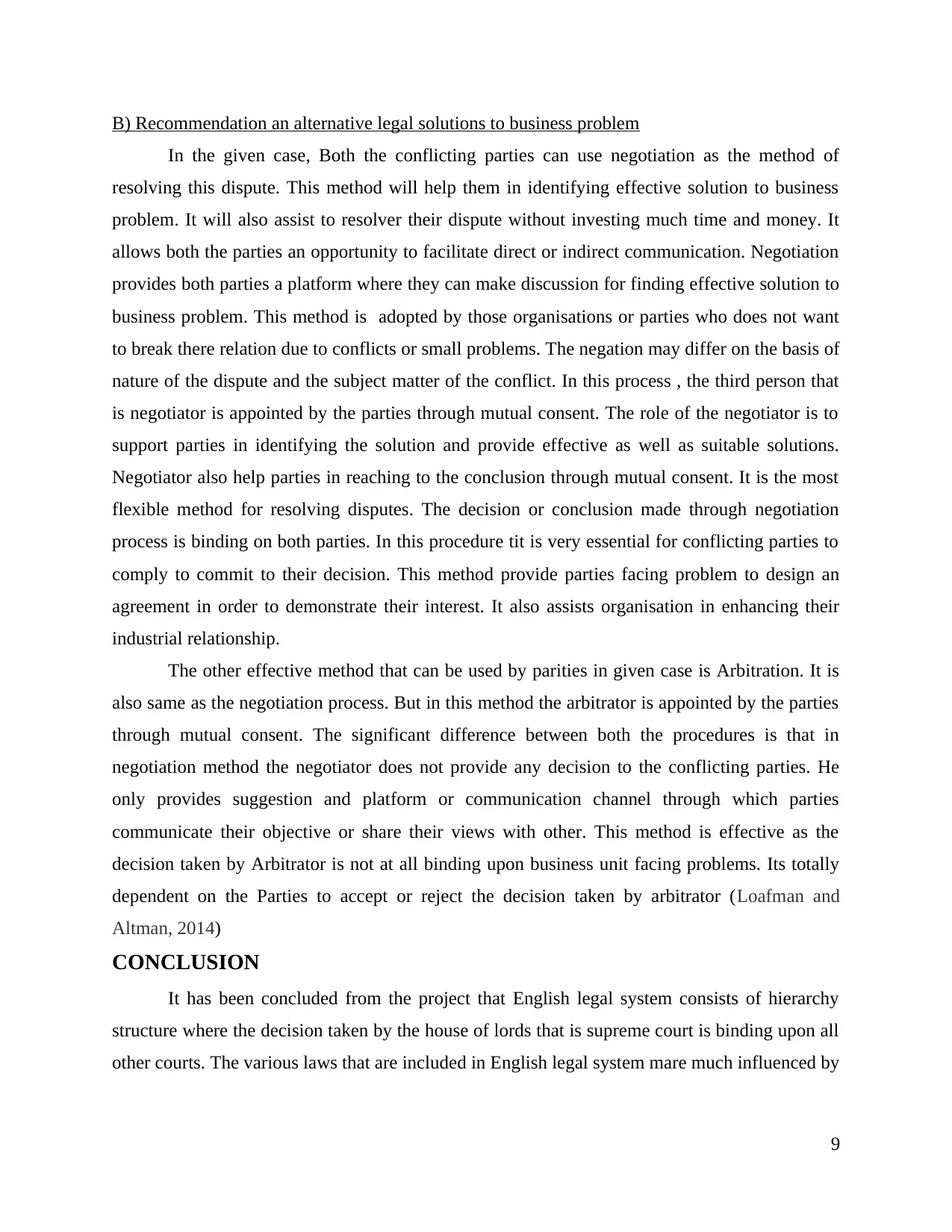
B) Recommendation an alternative legal solutions to business problem
In the given case, Both the conflicting parties can use negotiation as the method of
resolving this dispute. This method will help them in identifying effective solution to business
problem. It will also assist to resolver their dispute without investing much time and money. It
allows both the parties an opportunity to facilitate direct or indirect communication. Negotiation
provides both parties a platform where they can make discussion for finding effective solution to
business problem. This method is adopted by those organisations or parties who does not want
to break there relation due to conflicts or small problems. The negation may differ on the basis of
nature of the dispute and the subject matter of the conflict. In this process , the third person that
is negotiator is appointed by the parties through mutual consent. The role of the negotiator is to
support parties in identifying the solution and provide effective as well as suitable solutions.
Negotiator also help parties in reaching to the conclusion through mutual consent. It is the most
flexible method for resolving disputes. The decision or conclusion made through negotiation
process is binding on both parties. In this procedure tit is very essential for conflicting parties to
comply to commit to their decision. This method provide parties facing problem to design an
agreement in order to demonstrate their interest. It also assists organisation in enhancing their
industrial relationship.
The other effective method that can be used by parities in given case is Arbitration. It is
also same as the negotiation process. But in this method the arbitrator is appointed by the parties
through mutual consent. The significant difference between both the procedures is that in
negotiation method the negotiator does not provide any decision to the conflicting parties. He
only provides suggestion and platform or communication channel through which parties
communicate their objective or share their views with other. This method is effective as the
decision taken by Arbitrator is not at all binding upon business unit facing problems. Its totally
dependent on the Parties to accept or reject the decision taken by arbitrator (Loafman and
Altman, 2014)
CONCLUSION
It has been concluded from the project that English legal system consists of hierarchy
structure where the decision taken by the house of lords that is supreme court is binding upon all
other courts. The various laws that are included in English legal system mare much influenced by
9
In the given case, Both the conflicting parties can use negotiation as the method of
resolving this dispute. This method will help them in identifying effective solution to business
problem. It will also assist to resolver their dispute without investing much time and money. It
allows both the parties an opportunity to facilitate direct or indirect communication. Negotiation
provides both parties a platform where they can make discussion for finding effective solution to
business problem. This method is adopted by those organisations or parties who does not want
to break there relation due to conflicts or small problems. The negation may differ on the basis of
nature of the dispute and the subject matter of the conflict. In this process , the third person that
is negotiator is appointed by the parties through mutual consent. The role of the negotiator is to
support parties in identifying the solution and provide effective as well as suitable solutions.
Negotiator also help parties in reaching to the conclusion through mutual consent. It is the most
flexible method for resolving disputes. The decision or conclusion made through negotiation
process is binding on both parties. In this procedure tit is very essential for conflicting parties to
comply to commit to their decision. This method provide parties facing problem to design an
agreement in order to demonstrate their interest. It also assists organisation in enhancing their
industrial relationship.
The other effective method that can be used by parities in given case is Arbitration. It is
also same as the negotiation process. But in this method the arbitrator is appointed by the parties
through mutual consent. The significant difference between both the procedures is that in
negotiation method the negotiator does not provide any decision to the conflicting parties. He
only provides suggestion and platform or communication channel through which parties
communicate their objective or share their views with other. This method is effective as the
decision taken by Arbitrator is not at all binding upon business unit facing problems. Its totally
dependent on the Parties to accept or reject the decision taken by arbitrator (Loafman and
Altman, 2014)
CONCLUSION
It has been concluded from the project that English legal system consists of hierarchy
structure where the decision taken by the house of lords that is supreme court is binding upon all
other courts. The various laws that are included in English legal system mare much influenced by
9
⊘ This is a preview!⊘
Do you want full access?
Subscribe today to unlock all pages.

Trusted by 1+ million students worldwide
1 out of 14
Related Documents
Your All-in-One AI-Powered Toolkit for Academic Success.
+13062052269
info@desklib.com
Available 24*7 on WhatsApp / Email
![[object Object]](/_next/static/media/star-bottom.7253800d.svg)
Unlock your academic potential
Copyright © 2020–2025 A2Z Services. All Rights Reserved. Developed and managed by ZUCOL.





